 Until about 500 to 425 million years ago (mya), all organisms
were aquatic, including simple algae, fungi, several phyla of invertebrates,
and a few vertebrates such as fish.
Until about 500 to 425 million years ago (mya), all organisms
were aquatic, including simple algae, fungi, several phyla of invertebrates,
and a few vertebrates such as fish.
Plate tectonics and continental drift are “computer-age” theories. Using computers, the best fit of the shapes of the continents was determined, and the shapes were moved around based on current rates of continental movement (5 to 10 cm/yr). The results have then been compared with existing fossils and other geological evidence.
 Until about 500 to 425 million years ago (mya), all organisms
were aquatic, including simple algae, fungi, several phyla of invertebrates,
and a few vertebrates such as fish.
Until about 500 to 425 million years ago (mya), all organisms
were aquatic, including simple algae, fungi, several phyla of invertebrates,
and a few vertebrates such as fish.
 Around 500 to 425 mya, the first
land-dwelling organisms appeared, including simple plants and arthropods.
At that time, there were a couple major continents, and the area that
included what is now the Atlantic coast of North America and the hump of
Africa (which were joined together) was over the South Pole.
Later, this land mass gradually shifted northward on “our” side of the Earth
as the continents approached each other.
Around 500 to 425 mya, the first
land-dwelling organisms appeared, including simple plants and arthropods.
At that time, there were a couple major continents, and the area that
included what is now the Atlantic coast of North America and the hump of
Africa (which were joined together) was over the South Pole.
Later, this land mass gradually shifted northward on “our” side of the Earth
as the continents approached each other.
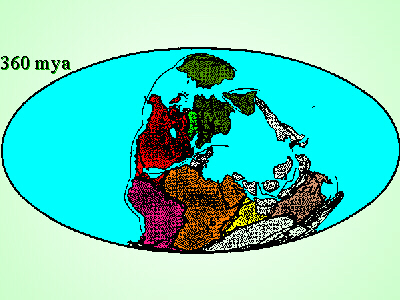 About 360 to 340 mya, during the
Paleozoic Era,
there were two major continents. One, called Gondwana, included what
is now Africa, South America, Australia, Antarctica, and India. The other
included North America and much of what is now Eurasia.
The climate on the North America-Eurasia continent was equatorial and warm,
and the main biomes were swamps and/or tropical rainforests.
There were many amphibians, as well as insects, spiders, and other arthropods.
About 360 to 340 mya, during the
Paleozoic Era,
there were two major continents. One, called Gondwana, included what
is now Africa, South America, Australia, Antarctica, and India. The other
included North America and much of what is now Eurasia.
The climate on the North America-Eurasia continent was equatorial and warm,
and the main biomes were swamps and/or tropical rainforests.
There were many amphibians, as well as insects, spiders, and other arthropods.
 Vegetation included a variety of ferns and large tree-like relatives of
present-day Lycopodium. These organisms were able to spread throughout
this continent anywhere it was warm enough, thus their descendants may be seen
throughout present-day North America and Eurasia.
Subsequent climactic changes killed large numbers of organisms, which now are
the coal that is mined here in North America and in England.
Vegetation included a variety of ferns and large tree-like relatives of
present-day Lycopodium. These organisms were able to spread throughout
this continent anywhere it was warm enough, thus their descendants may be seen
throughout present-day North America and Eurasia.
Subsequent climactic changes killed large numbers of organisms, which now are
the coal that is mined here in North America and in England.
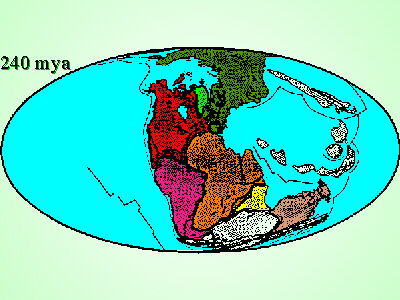 Approximately 280 mya, Africa and the Atlantic coast of North America “collided,”
and the pressure of Africa on North America caused the Appalachian Mountains
to be formed. Geologically, the Appalachians are much older than the Rockies,
thus are considerably more worn down.
Similarly, a collision of Europe and Asia caused the Ural Mountains (a
north-south mountain range in the middle of Russia) to be formed.
Approximately 280 mya, Africa and the Atlantic coast of North America “collided,”
and the pressure of Africa on North America caused the Appalachian Mountains
to be formed. Geologically, the Appalachians are much older than the Rockies,
thus are considerably more worn down.
Similarly, a collision of Europe and Asia caused the Ural Mountains (a
north-south mountain range in the middle of Russia) to be formed.
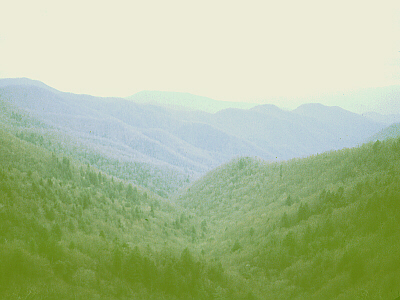
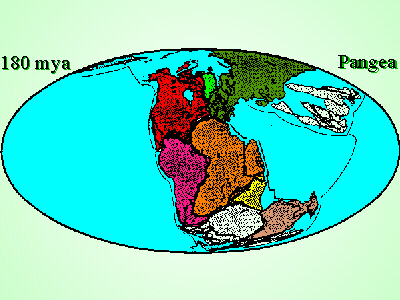 By about 180 mya, nearly all the land was pretty much united in one large
continent called
Pangea,
and thus, all the water was in one large ocean called
Panthalassa.
This time period is the Jurassic Period of the
Mesozoic Era,
and has been nicknamed the “age of dinosaurs” because of their prominence.
In addition to dinosaurs, there were many species of cockroaches, other
reptiles, and gymnosperms including conifers and cycads.
By about 180 mya, nearly all the land was pretty much united in one large
continent called
Pangea,
and thus, all the water was in one large ocean called
Panthalassa.
This time period is the Jurassic Period of the
Mesozoic Era,
and has been nicknamed the “age of dinosaurs” because of their prominence.
In addition to dinosaurs, there were many species of cockroaches, other
reptiles, and gymnosperms including conifers and cycads.
 It is thought that the very first birds and mammals appeared near the end of
this time period.
Because the land mass was all united and organisms could spread anywhere on
it that provided a suitable habitat,
life forms or their ancestors present at that time are represented on all
present continents, whereas
types of organisms that appeared later (after the break-up pf Pangea) are
only found certain places.
It is thought that the very first birds and mammals appeared near the end of
this time period.
Because the land mass was all united and organisms could spread anywhere on
it that provided a suitable habitat,
life forms or their ancestors present at that time are represented on all
present continents, whereas
types of organisms that appeared later (after the break-up pf Pangea) are
only found certain places.
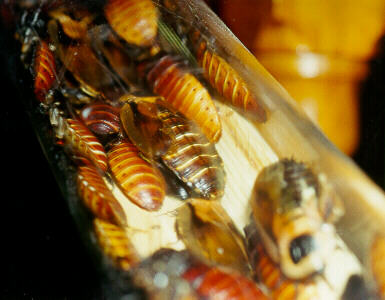
 Sometime between 180 and 120 mya, Pangea started to break apart. The northern
continent formed from this was called Laurasia and consisted of what
are now North America, Greenland, Europe, and Asia.
Gondwana, the southern continent, was made up of South America, Africa,
Australia, India, and Antarctica. The climate included warm, tropical and
subtropical areas. Because of the warmth, the oceans were high and covered
much of the land, limiting movement.
During this time, angiosperms, mammals, birds, appeared.
Sometime between 180 and 120 mya, Pangea started to break apart. The northern
continent formed from this was called Laurasia and consisted of what
are now North America, Greenland, Europe, and Asia.
Gondwana, the southern continent, was made up of South America, Africa,
Australia, India, and Antarctica. The climate included warm, tropical and
subtropical areas. Because of the warmth, the oceans were high and covered
much of the land, limiting movement.
During this time, angiosperms, mammals, birds, appeared.
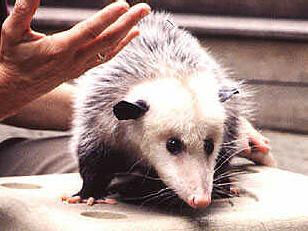 About 120 mya, Gondwana broke into three pieces, including South America/Africa,
India, and Australia/Antarctica. At this time, India started going its own
way. Initially, the tip of South America was very close to Antarctica.
As this split was occurring, the first
marsupials
evolved on Laurasia and spread south to Gondwana as the split was occurring.
When the marsupials spread as far as the south end of South America, there
was still a land bridge between South America and the Antarctica/Australia
continent, so marsupials were able to spread to the Antarctica/Australia
continent.
As the climate changed and became a little cooler, the dinosaurs declined.
About 120 mya, Gondwana broke into three pieces, including South America/Africa,
India, and Australia/Antarctica. At this time, India started going its own
way. Initially, the tip of South America was very close to Antarctica.
As this split was occurring, the first
marsupials
evolved on Laurasia and spread south to Gondwana as the split was occurring.
When the marsupials spread as far as the south end of South America, there
was still a land bridge between South America and the Antarctica/Australia
continent, so marsupials were able to spread to the Antarctica/Australia
continent.
As the climate changed and became a little cooler, the dinosaurs declined.
At about 100 mya, South America and Africa split.
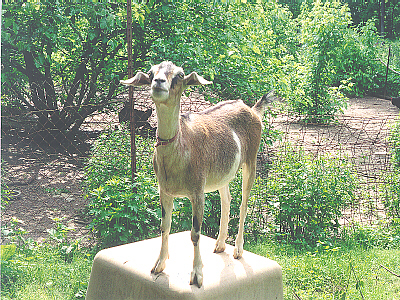 Some time in here,
placental mammals
also arose on Laurasia, and subsequently spread to South America, Africa, and India when those crashed into the northern continent(s).
However, by the time the placentals spread to the south end of South America, there was no longer a
bridge to Antarctica/Australia, so the placental mammals couldn't get there. This is significant because, wherever placentals went, they
out-competed the marsupials (meaning natural selection/more fit, not that they got into fights!) and marsupials, except opossums died off.
Some time in here,
placental mammals
also arose on Laurasia, and subsequently spread to South America, Africa, and India when those crashed into the northern continent(s).
However, by the time the placentals spread to the south end of South America, there was no longer a
bridge to Antarctica/Australia, so the placental mammals couldn't get there. This is significant because, wherever placentals went, they
out-competed the marsupials (meaning natural selection/more fit, not that they got into fights!) and marsupials, except opossums died off.
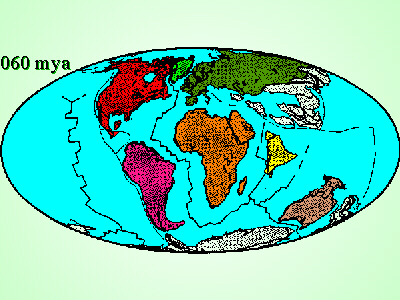 Around 60 to 50 mya, Laurasia split into North America, Greenland, and Eurasia. Again, just prior to this split, Laurasia was the site
of evolution of the placental mammals which moved south, out-competing the marsupials.
Between then and now, Africa and Saudi Arabia collided with Eurasia and India collided with Asia forming the Himalayan Mountains. Thus
mammals from Eurasia could spread to those places. North and South America touched and a land bridge formed across the isthmus of Panama.
More recently evolved plants and animals could use these new land bridges to migrate to areas formerly separated by ocean. However, it is important to note that none of them could reach
the Antarctica/Australia continent.
Around 60 to 50 mya, Laurasia split into North America, Greenland, and Eurasia. Again, just prior to this split, Laurasia was the site
of evolution of the placental mammals which moved south, out-competing the marsupials.
Between then and now, Africa and Saudi Arabia collided with Eurasia and India collided with Asia forming the Himalayan Mountains. Thus
mammals from Eurasia could spread to those places. North and South America touched and a land bridge formed across the isthmus of Panama.
More recently evolved plants and animals could use these new land bridges to migrate to areas formerly separated by ocean. However, it is important to note that none of them could reach
the Antarctica/Australia continent.
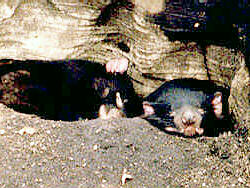 Eventually, Australia and Antarctica split from each other. Antarctica went to
the South Pole and became too cold, killing all the mammals (marsupials)
present there.
Australia went north to near the equator, and its marsupials thrived. With
no competition from
placentals. Australian marsupials evolved/diversified to fill all the niches
filled by placentals
elsewhere: kangaroo are grazers like cattle, koalas eat tree leaves like
giraffes, marsupial dogs and Tasmanian devils are predators.
Eventually, Australia and Antarctica split from each other. Antarctica went to
the South Pole and became too cold, killing all the mammals (marsupials)
present there.
Australia went north to near the equator, and its marsupials thrived. With
no competition from
placentals. Australian marsupials evolved/diversified to fill all the niches
filled by placentals
elsewhere: kangaroo are grazers like cattle, koalas eat tree leaves like
giraffes, marsupial dogs and Tasmanian devils are predators.
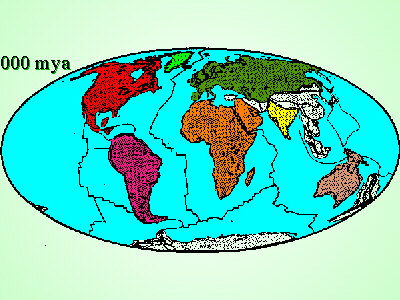 The ice ages occurred about 2 mya. Ice sheets and glaciers separated
populations of organisms which, being then in different habitats, had
different selective pressures acting on their alleles and thus
evolved into different species. This has resulted in the large
variety/number of species we see today we see today, especially in
“northern” genera.
The ice ages occurred about 2 mya. Ice sheets and glaciers separated
populations of organisms which, being then in different habitats, had
different selective pressures acting on their alleles and thus
evolved into different species. This has resulted in the large
variety/number of species we see today we see today, especially in
“northern” genera.
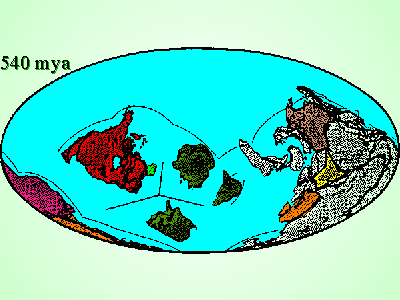 Here is an animation of the process of continental drift. Note that the
images will change somewhat slowly to allow you to view each one.
Click on the animation to re-start it.
Here is an animation of the process of continental drift. Note that the
images will change somewhat slowly to allow you to view each one.
Click on the animation to re-start it.
These maps were modified from those in
Beatty, J. Kelly and Andrew Chaikin. 1990. The New Solar System, 3ed Ed. Cambridge Univ. Press. NY.